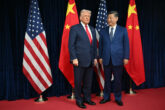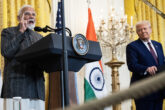March 17, 2020
We learned resilience after 9/11. But it’s the wrong kind for combatting a virus.
Ever since the attacks of 9/11 shocked the nation, Americans have been urged by political leaders to learn resilience in the face of terrorism. That’s been critical to improving our ability to withstand such attacks when they occur and to show terrorists that their strategy won’t have the effects they desire. Now, we face our nation’s scariest moment since then: a virus that’s killed thousands around the world and that’s infecting thousands of Americans — and spreading. But the same resilience that we learned to show in the face of terrorism — centered on continuing with everyday life — isn’t strategic, wise or tough in the face of this new threat. It’s dangerous, foolish and selfish. At a pivotal moment for slowing the spread of coronavirus on U.S. soil, Americans need to learn a new kind of resilience that’s the opposite of what they’ve spent 20 years cultivating — and fast.
It was soon after 9/11 that Americans were first exhorted not to let the devastating attacks of that day interfere with ordinary life. Within weeks, President George W. Bush was encouraging Americans “to go about their lives, to fly on airplanes, to travel, to go to work.” He was right: Once the federal government felt confident that no second wave of al-Qaeda attacks was imminent, it was critical to America’s economy, society and collective psychology not to let the tragedy bring a superpower to a standstill. Showing national resilience in the face of terrorist attacks actually counters the effectiveness of those attacks: Terrorism is inherently a strategy of provocation, and standing tough afterward actually thwarts terrorists’ very objectives. We’ve both worked on counterterrorism in the U.S. government — one in the year before and decade after 9/11 at the Justice Department and Office of the Director of National Intelligence, the other for much of the last decade at the Justice Department and National Security Council — and we both believe strongly in the value of building resilience in the face of terrorism.
Read the full article in The Washington Post.
More from CNAS
-
Indo-Pacific Security / Energy, Economics & Security
How to Win the Economic War with ChinaTrump's approach to China has run aground, giving Beijing unprecedented advantage in the economic conflict....
By Edward Fishman & Julian Gewirtz
-
America’s Self-Loathing Is a Losing Hand
This article was originally published in The Washington Post.Around 10 years ago, the United States began a historic shift in its grand strategy toward China, abandoning the b...
By David Feith
-
Indo-Pacific Security / Energy, Economics & Security / Technology & National Security
Selling AI Chips Won’t Keep China Hooked on U.S. TechnologyU.S. policy should not rest on the illusion that selling chips can trap China inside the American tech ecosystem....
By Janet Egan
-
Will New Delhi-Beijing Move Beyond Friction Points? | Ex-White Official On India-China Reset
Prime Minister Narendra Modi on Friday said that India and China, as two major economies, must work together to bring stability to the global economic order. NDTV's Gaurie Dwi...
By Lisa Curtis




